
A member of the Oregon Department of Transportation’s executive team was overcome with emotion and had to walk out of a meeting Tuesday night after he broke the news of a major funding shortfall and construction delay for the I-5 Rose Quarter project.
Since ODOT convened the Historic Albina Advisory Board in September 2020, they’ve built up expectations with Black residents of north Portland who make up the group that the “generational project” would lead to hundreds of well-paying jobs and multi-million dollar construction contracts for Black-owned firms. But a recent reckoning with financial reality spurred on by years of choices that favored expensive freeway expansion megaprojects, combined with a pause on tolling by Governor Tina Kotek has thrown a wrench into ODOT’s plans.
The rubber hit the road at Tuesday’s meeting of the HAAB where Finn had to share the bad news.
ODOT has spent $115 million on the Rose Quarter project thus far, despite not breaking any ground. They hoped to begin construction of the project later this year, but tolling was always a central component of paying for this project (and several other regional freeway projects that are part of their Urban Mobility Strategy). Without that source of revenue, ODOT’s house of cards has come tumbling down and they don’t have money to move forward.
At the HAAB meeting last night ODOT told members of the committee that they likely will not begin any construction until early 2025 — and that’s only if major new funding becomes available. With the estimated cost ballooning to $1.5 to $1.9 billion, ODOT will have to pull down a major federal grant if no other state revenue comes around.
This decision came only after Kotek paused the collection of tolls until 2026 and then required ODOT to come up with a financial plan for these projects using the funding they have in the bank right now. “We face the need to manage our spending more conservatively,” read an ODOT statement about the financing plan.
Brendan Finn is manager of ODOT’s Urban Mobility Office that oversees the I-5 Rose Quarter and other projects in the Urban Mobility Strategy. At the HAAB meeting last night he broke the news that ODOT will invest just $44 million more dollars into the project — enough to complete the designs and bring them to a point that makes the project competitive for major federal grants. But that won’t be enough to start construction and the flow of jobs that would come with it.
HAAB members felt blindsided by the news and their anger was palpable.
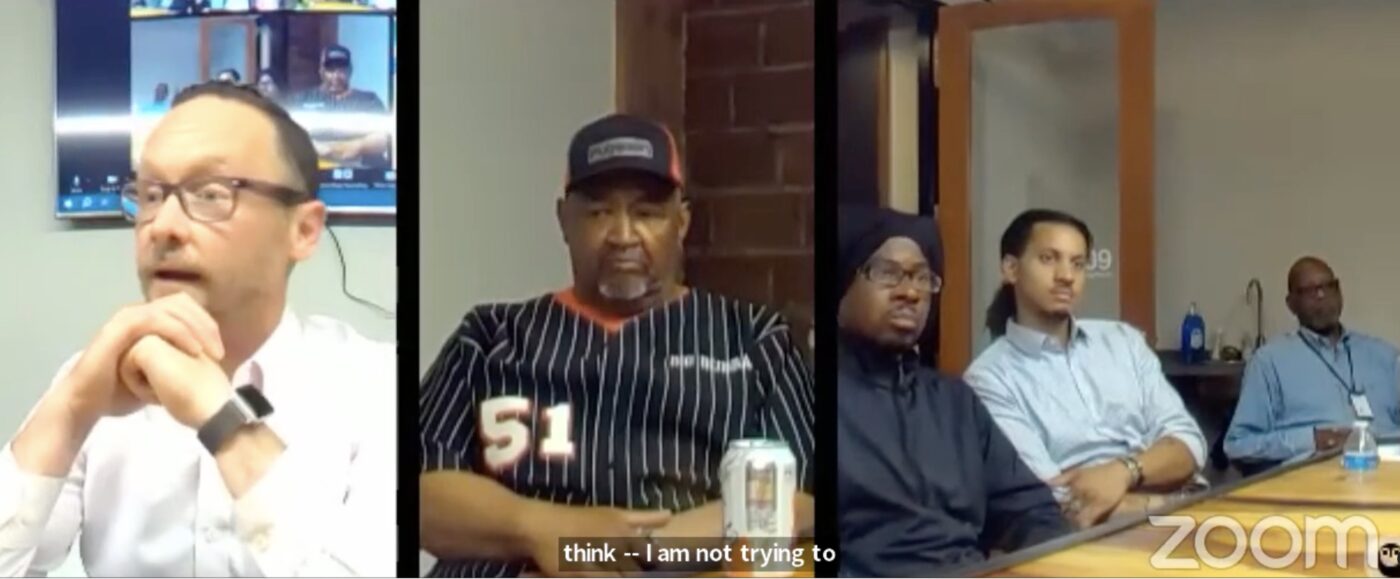

“This is all news to me. I’ve been fighting for this project for about four years now, and all of a sudden we get up to this point and the funding is in jeopardy?” said HAAB member James Posey, a co-founder of the National Association of Minority Contractors of Oregon. “I’m confused because I thought the governor had worked out a deal.” (Posey was referring to the deal former Governor Kate Brown made in August 2021 to endorse a project that included large highway lids that could aid in the redevelopment of Albina.)
“I’m disappointed that the slowdown order was issued in such a way that it would impact this project,” added another HAAB member, former Portland Police Officer Kevin Modica. Here’s more from Modica:
“If you’re listening from the governor’s office, this is not fair. We have an expectation to see you at this table. Don’t send spoiled fruit as the meal is served by someone that you can hide behind. This is not right. This is not okay. We have prime contractors that are building their business and forecasting — and now it’s another 24 months off. It’s not okay.
Governor Kotek, this is a huge disappointment. Huge.”
Several HAAB members made it clear they were not mad at Finn (“This isn’t about you,” they repeated), but wanted more accountability from Governor Kotek. They also expressed that it was unfair that white politicians from Clackamas County were able to win a pause on tolling and that freeways projects in places like Wilsonville will still move forward. “This sounds like to me, big politics,” one HAAB member commented. “It’s interesting to me how some people cry and they get heard and a process gets paused for two years, and other communities cry and get heard and the process continues.”
Even though they made it clear they weren’t directing their comments toward Finn, he still took it personally. “I know you said it’s not personal, but I take it personally that I did come to many of you and we said we wanted to establish trust,” he said.
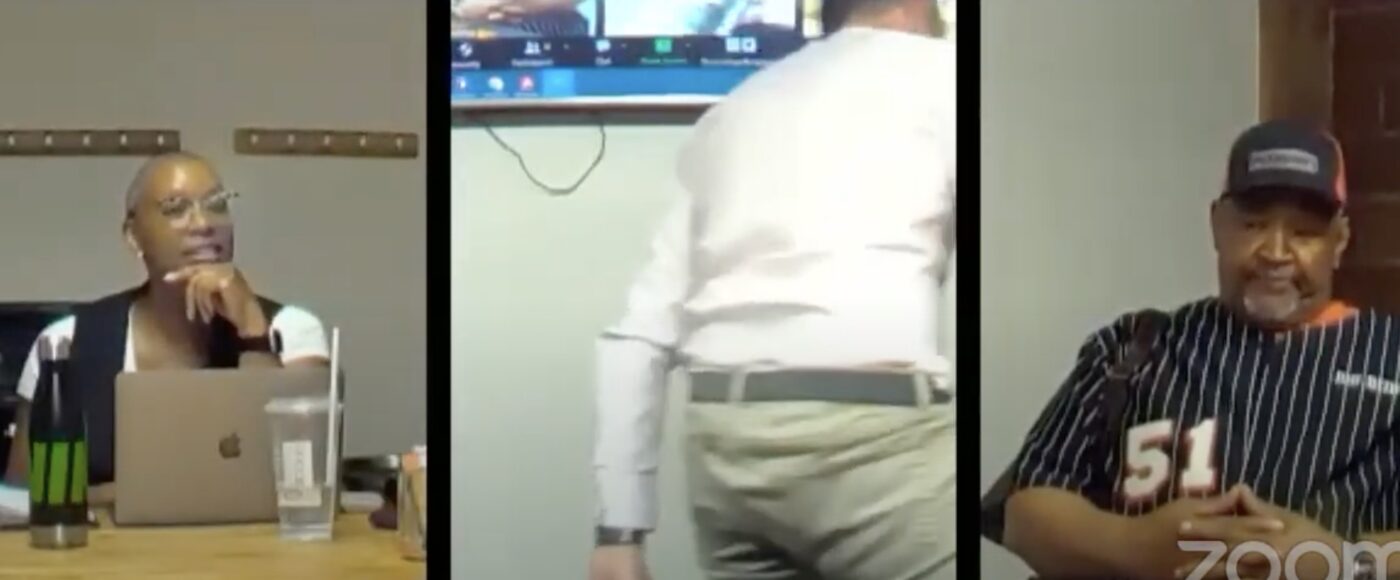
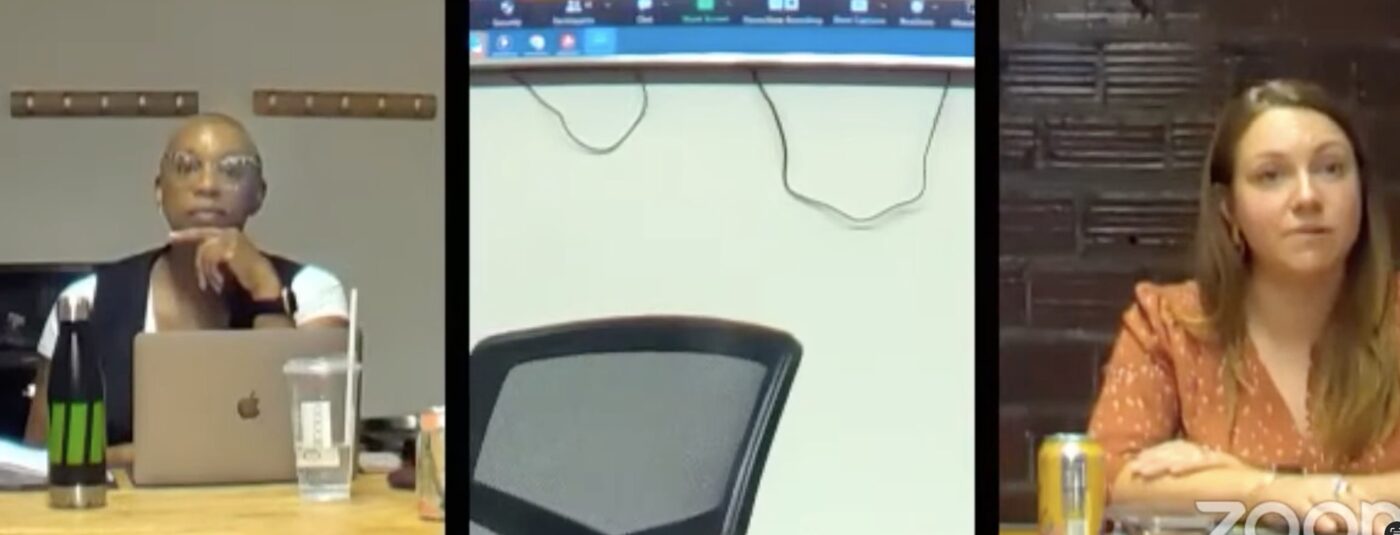
“We need to keep this [project] going,” Finn said at one point, trying muster optimism. “This can’t be what happened to the Columbia River Crossing [a project that failed in 2013, only to be resurrected as the Interstate Bridge Replacement Program]. This project is generational. And we can’t stop the momentum. It would be easy, I think for some to say, ‘You don’t have the funding for construction.’ But neither did Interstate Bridge three years ago. So there’s some strategy to be had. There’s some voices to be heard. So we can get there.”
HAAB member John Washington wants to be one of those voices to be heard. He encouraged people on the committee to not let the decision stand. “The question I have is, what’s the muscle in this room as a response to us being pushed around? Because for far too long we’ve been passive recipients of this kind of stuff. You brought us a dream and a vision, now there’s another vision to be deferred in our lifetime? I got some issues with that part of it.”
Then Washington appealed directly to Finn. “It’s time to grow a set, B[rendan]. It’s time to step up to the plate. If you want to displace all these relationships you helped develop?… If I were you I’d go into that office with your staff and your director and tell them what you’ve established right here and somehow gain some kind of opening for us to navigate through the rest of the way.”
Finn has spent years building trust and friendships with the people in that room Tuesday night. They clearly see him as an ally and conduit to state influence. Given that, it’s easy to see how heavy the weight of this bad news was on Finn’s shoulders.
Toward the end of the meeting, Modica asked Finn if he was ready to carry the message from this group to the OTC at a special meeting on the financing plan that was held yesterday.
“I think where I want to start with them [the OTC] is… just… well… I need to gather my thoughts right now, I’m actually kind of emotional,” Finn said as he removed his glasses and wiped his eyes. “And I apologize,” he continued. And then Finn got up and walked away as HAAB members looked on and his empty chair swiveled on the video screen. (Watch the clip below.)
At their meeting Wednesday, the OTC voted to adopt ODOT’s updated financing plan. That plan includes the $44 million in design work for the Rose Quarter and an indefinite postponement of the second phase of a planned I-205 freeway expansion.



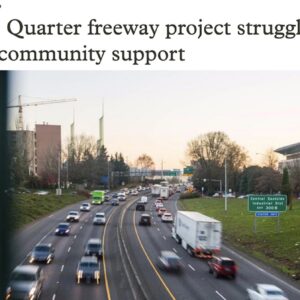
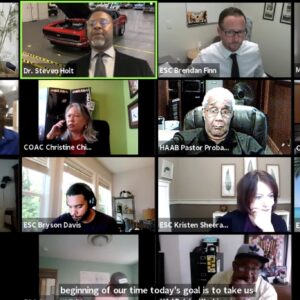


Thanks for reading.
BikePortland has served this community with independent community journalism since 2005. We rely on subscriptions from readers like you to survive. Your financial support is vital in keeping this valuable resource alive and well.
Please subscribe today to strengthen and expand our work.
I am sure that the disappointment at this meeting was genuine, but there is also a fair amount of political theater and denial. Acting like this came out of nowhere either shows that the HAAB members and Finn haven’t been following the project developments that closely or that they have decided that the best play is to maximize their position by pretending that no one saw this coming and it is unfair that they have sunk costs that can’t be recovered. The latter seems more likely, but I am surprised that people are buying it.
Pivoting to blame Kotek is predictable, but also disingenuous given the bad faith negotiations that ODOT has had with the community over the years. We should remember that the HAAB was added to the project later on, after it faced signifiant opposition and risk of failure to progress.
I have no sympathy for Finn who has pushed ODOT’s deception. Maybe this is a good time for Finn and others to take a look in the mirror and decide if they want to stay committed to fiscally irresponsible, anachronistic projects.
It’s wild how openly the HAAB members are like ‘we want to get paid’ and there really isn’t a pretense that the project will actually benefit anyone isn’t paid to work on it.
The Rose Quarter is just ODOT’s Vietnam. They lied about why it was necessary, they lied about the cost, they lied about the time it’d take to achieve success. The end results will be dead space reclaimed land that you can’t build on and wont want to hang out on, and traffic congestion will be just as bad.
IMO, wealth transfers are not in themselves a good enough reason to do a project. Black contracters can build lots of projects that actually benefit the community. With the corrupt SCOTUS ruling today, the writing is on the wall for race-based contracting anyway. They should focus on shovel ready stuff while they still can.
Pretty gross and disrespectful language.
Yeah, that’s a really disrespectful and awful thing to say to a public servant who is just doing his job and is really just the messenger in this case. These decisions were made at a high level in the legislature and governor’s office, and it’s not okay to disparage and denigrate Finn in this way. And it clearly affected him quite a bit on an emotional level.
to be clear, the person who said that — and most everyone else who spoke up in the meeting – were very fond of and respectful of Finn. They see Finn as their emissary and they trusted him. That’s why Finn is so impacted by this. He has personal connections to these folks now… and he had to see their disappointment because of what his agency decided to do. Fascinating human drama.
Perhaps I should make it more clear in the story that committee members fully support Finn and kept saying, “This isn’t about you Brendan, it’s about the governor, etc…”
I guess the political machine still doesn’t care about that area after running the freeway through there in the first place. The machine used the situation to enrich their own people to the tune of $115 million and dangled the prospect of more to come to get through the election cycle. Now that that’s past, the people voted the right way and now the political machine doesn’t care. I imagine they’ll find the prospect for more money the next time they need votes for something. A clear case of getting exactly what one voted for. I have no idea why Oregon keeps voting the same people into power time and time again.
Not much we can do about #1. #2 and #3 would neatly be solved by Petition 2024-011: https://sos.oregon.gov/elections/Pages/initiatives-referendums-referrals.aspx – find a way to sign it if you can!
I’m not 100% sold on ranked voting, but I will consider it. I am for sure against the single party system that seems to have developed and I suppose that ranked voting is more probable than the emergence of 2 or more sane parties to challenge the current single party.
Oh, to clarify, 2024-011 is for STAR, not RCV. Though if the STAR petition makes it, Oregonians will be voting on both next year. You are right to have reservations about the RCV route, though – that one does not do away with partisan primaries (as I understand what passed, to be fair) and does not eliminate the spoiler effect (it…dulls and obscures it, but it’s very much still there), so it’s unlikely to actually produce any difference in outcomes to our current system.
Thank you for the polite correction! I feel like I need to catch up a bit with the goings ons. I will do a better read than a quick skim:-)
Personally, I think an open primary would be preferable, so we have time to learn more about the candidates before making a final choice.
Why aren’t HAAB contractors given contracts for other projects? They were clearly being used to bolster this unpopular, highly questionable project, but if ODOT was serious about helping the community they have historically destroyed and disadvantaged, it would make sense to offer these contractors other projects.
I agree. I’d like to see them build the Salmonberry Trail.
Were the contractors displaced by the construction of I-5?
The heart of the Albina District was bulldozed for I-5 during the 1950s and 1960s. It’s very likely that local minority contractors have friends and family who were directly displaced, or were even displaced themselves. That said, who cares whether they personally experienced displacement? The destruction of communities has long-lasting cultural and financial impacts that span generations.
“who cares whether they personally experienced displacement?”
Clearly not race essentialists.
How do you propose to undo the damage of systemic racism without accounting for race?
The thought that one has to be racist to solve racism is such a weird concept.
Maybe it’s time to take the race out everything.
Hiring practices that are double blind.
Financial applications have no indicators of race in the form.
The census quits asking the dumb race question.
Those are just 3 off the top of my head, and yes some of those would have to be legislated, but it’s better than to continue being racist. Race has been focus for hundreds maybe thousands of years, maybe its time to try something completely different.
“Maybe it’s time to take the race out everything.”
Cool, what a concept.
So everyone is exactly equal?
So the tax and income distribution in this country for the last 200 plus years is ignored and we all start at zero?
Slavery and Jim Crow laws that only kind of ended (if you have been in the rural south recently, not so much) about 50 years ago have no effect on generations?
Inherited wealth is all just ignored?
Your family history is just like mine? We are just the same, all have equal wealth and opportunity and no other factors should come into play in this complicated world?
Just pick yourself up by your bootstraps?
You are hilarious whoever you are.
You and Daniel are definitely in the minority on your opinion on the racial affirmative action concept (even amongst Democrats!). Take a look at this from the NYT’s
This is just a stupid poll… Ask the same question about legacy admissions? Also just because the general public might be racist is no reason our laws and policies should be. If you rely on opinion polls we probably would not have had the 1965 Civil rights act at all.
It’s Hilarious that Clarence Thomas got into Yale because of racial quotas but thinks he made it on his own… kind of like this poll….
“Ask the same question about legacy admissions?”
Let’s just stipulate that everyone here would be happy getting rid of legacy admissions. I know why universities like them (they generate huge amounts of cash, some of which can be used to provide scholarships for talented people who otherwise couldn’t afford to go to school), but I don’t work in development or financial aid, so it’s easy for me to agree they are unfair and we should just get rid of them. Begone!
I will add that some of the less enlightened folk believe it is racist to deny an Asian (or Jewish) kid admission because he’s Asian (or Jewish) and “we’ve got enough of your kind already.”
Good thing white conservative billionaires are unable to sway public opinion on social issues by, say, buying up entire media outlets…
https://amp.theguardian.com/us-news/2017/nov/27/koch-brothers-time-magazine-media-power
“So everyone is exactly equal?”
“Equal” is a difficult word because it contains so many nuanced meanings, which makes your use of it feel like a trap.
When it comes to legal treatment by the government, everyone should be treated the same, regardless of wealth or family history, race, class, or whatever. I think this
is an aspiration that the vast majority of Americans believe in.
That is very different than asserting that life outcomes should be identical for all people, which is of course an impossible and probably undesirable goal.
Which version of “equal” do you mean?
“When it comes to legal treatment by the government, everyone should be treated the same, regardless of wealth or family history, race, class, or whatever. I think this
is an aspiration that the vast majority of Americans believe in.
What a simplistic response.
Of course that is the goal but getting there requires some nuance which you and the current members of SCOTUS don’t have…
Is the education at Jefferson high school on par with the education at Catlin Gable?
Are the schools in Lake Oswego the same as the schools in St. Johns?
How do you account for that in your “equal” world?
43% of admissions to Harvard are legacy admissions, they did not “earn” their way in at all.
There is no “fairness” in the current system at all which is what affirmative action tries to remedy.
You have no better answers than Clarence Thomas does it is clear.
This quote that was directed at Justice Jackson seems equally applicable to your stance.
“we are all inexorably trapped in a fundamentally racist society, with the original sin of slavery and the historical subjugation of Black Americans still determining our lives today.”
I don’t know what “fairness” means to you, but I do know what equality under the law is, and we should continue working towards realizing that goal.
We simply disagree that discriminating affecting Asian kids on the basis of race will somehow make things better. I find the practice pretty offensive, but we can just agree to disagree on that one.
(If you are expecting me to defend Harvard’s 14% legacy admission rate (not quite 43%), I absolutely won’t. Take it up with Harvard.)
https://www.forbes.com/sites/michaeltnietzel/2022/10/30/legacy-college-admissions-come-under-fire-in-new-report/?sh=4ecba9145f07
For the last time, no one is discriminating against asian students.
They are well represented, look at the numbers.
Agreeing with the corrupt racists on this Supreme court is pretty damn offensive to me but you do you….
“no one is discriminating against asian students.”
If the admission standards differ by race, that is discrimination.
“They are well represented, look at the numbers.”
I’m sure that’s very comforting to the kids who didn’t get in solely because of their race.
There are differing admissions standards, but they have nothing to do with affirmative action.
“A 2019 study found almost half—43%—of white students who got into Harvard and so because they have legacy connections, their parents have donated large sums of money, or they are student athletes … The study concluded that ‘removing preferences for athletes and legacies would significantly alter the racial distribution of admitted students, with the share of white admits falling and all other groups rising or remaining unchanged.'”
https://www.npr.org/2023/07/02/1183981097/affirmative-action-asian-americans-poc
Everyone being treated the same by the government could mean a robust social safety net and a guaranteed basic income for everyone, or it could mean obliterating all social safety nets and providing exactly zero help to anyone. A situation where rich and poor are like are forbidden “to sleep under bridges, to beg in the streets, and to steal their bread”. Sounds fair!
*rich and poor alike
As someone who wants a robust safety net, nothing I’ve written elsewhere should be seen as disparaging that.
Except the US doesn’t have a robust social safety net, so the effect of the government treating everyone the same is that poor people and minorities get treated worse.
“Except the US doesn’t have a robust social safety net”
Agreed.
“so the effect of the government treating everyone the same is that poor people and minorities get treated worse.”
This deserves closer examination. Jefferson gets about 1.5x the funding per student as Grant does, but outcomes are not even remotely comparable. Do you really think we fix that by letting kids skate by in Harvard? When we fix Jefferson, the problems at Harvard will solve themselves.
I don’t know how to fix basic education in the US, but that is where we need to focus.
BTW, I’d be happy to double funding at Jefferson if there were any evidence it would help.
As Stanley Fish put it, “racism” is a cogent description of color-conscious policies “only if one considers the cancer of racism to be morally and medically indistinguishable from the therapy we apply to it”.
I’m no sociologist, but something tells me just ignoring the effects of 400 years of white supremacy is not going to fix racism.
Lol, yes, lets take race out of everything after one group in particular is severely disadvantaged for centuries. Do you not see the problem here? Is this not obvious to everyone?
“How do you propose to undo the damage of systemic racism without accounting for race?”
That’s an enormously complex question, but I would not start by creating a new regime of racial discrimination.
Instead, I would look at groups who have successfully overcome generations of pernicious discrimination and try to replicate their success.
When did this new regime of discrimination begin?
Do you have any idea?
One such regime began when someone decided that “too many Asians” were getting into Harvard.
Based on the Harvard diversity statistics, 39.7 percent of Harvard University’s enrolled student population is white, 13.7 percent of the population is Asian, 9.46 percent of the population is Hispanic or Latino, 6.56 percent of the population is black or African American, 3.94 percent of the population identifies as having more than one race, 0.197 percent of the population is American Indian or Alaska Native, and 0.118 percent of the population is Native Hawaiian or Other Pacific Islanders.
What are you talking about?
The lawsuit was brought by a white guy who misrepresented the case for Asians and the statistics for Harvard are very much in line with the overall population.
In fact since Asians are less than 7% of the population, they are over represented at Harvard.
There is nothing about those numbers that screams injustice except to the idiots on the Supreme court.
“What are you talking about?”
I’m talking about the lawsuit that Harvard just lost in front of the supreme Court. They got sued for discriminating against Asian students.
“SFFA’s lawsuit against Harvard is based in significant part on the challengers assertion that Harvard discriminates against Asian Americans, who have, on average, better standardized test scores and grades than any other ethnic group, including whites.”
https://www.npr.org/2022/10/31/1131789230/supreme-court-affirmative-action-harvard-unc
The lawsuit claimed they were not allowing enough Asians in … It Helps if you actually know something about the case before you hit send…
Yes, this is exactly what I’m talking about. Did I write something different?
So did Asians “successfully overcome generations of pernicious discrimination” or are they suffering harm under a “new regime of racial discrimination”? It can’t be both, can it?
It can!
Except there’s no substantial evidence of discrimination against Asian Americans at selective colleges like Harvard:
“We do not find compelling evidence of a significant ‘Asian penalty’ under the current holistic system … Asian American students benefit from holistic admissions just as other students do.”
https://cew.georgetown.edu/wp-content/uploads/cew-selective-bias-fr.pdf
A lot of smart people disagree with you, and some have explained a bit about what the evidence in the case showed. See David French’s informative opinion peice in NYT or Jay Caspian Kang’s interesting take in the New Yorker.
Kang makes the case that for all the smoke and noise, Harvard’s policy never really helped who it was purported to, and not much is going to change there or at the other elite colleges impacted by this decision. It’s also worth noting that the vast majority of college students attend schools that are not affected by this decision; in that regard, its scope is fairly narrow.
https://www.nytimes.com/2023/06/29/opinion/affirmative-action-supreme-court-harvard.html
https://www.newyorker.com/news/our-columnists/why-the-champions-of-affirmative-action-had-to-leave-asian-americans-behind
The former director of a Koch-funded think tank agrees with SCOTUS that affirmative action is bad. Big shocker!
Weird how opposing affirmative action has been such a priority for the right wing but finally outlawing it means “not much is going to change”. So was Harvard the vanguard of a “new regime of racial discrimination” or not?
Read Kang’s article. He explains it better than I could. But in short, Harvard was discriminating in a way that didn’t really benefit those you would want to benefit, and will probably find a way to continue doing so in a way that is more opaque.
In other words, “yes”.
Kang’s claims of discrimination are based on his own interpretation of the evidence presented to SCOTUS by the plaintiffs in the case. Personally I’m more inclined to trust the actual researchers behind the Georgetown report I linked to, who found no compelling evidence of discrimination, as opposed to a single journalist analyzing a skewed set of documents. But hey, that’s just me.
The discrimination faced by Asian Americans and Jews was fundamentally different than the discrimination faced by Black people. The “model minority” is a myth.
https://www.npr.org/2021/05/25/999874296/6-charts-that-dismantle-the-trope-of-asian-americans-as-a-model-minority
Yes, I agree with almost everything in that article. Thanks for posting it.
It’s looking very clearly like they are not and never have been serious. I’m sure individuals were serious about it and did their best, but for the organization as a whole and especially the planners who have profited handsomely I would say they did not.
I continue to be struck by the irony that the one thing that would allowing these projects to move forward is the tolling that anti-highway advocates fought so hard for. I testified in support of tolling, and now I feel duped. I wish I had just kept my fool mouth shut.
I agree! I support tolling but it is a weird place to be in.
On view is that tolling makes the real costs of transportation more transparent. Economists would argue that when costs are fully accounted for, decisions better reflect people’s preferences. So the fact that the governor put a moratorium on tolling that finance highway construction could be interpreted as showing that the full costs of highway construction finally are taken into account.
I found this striking:
So $150 Million on — what? Designs?
What could we have done with that money in terms of building bike infrastructure, investing in safety upgrades, and doing road repairs? And how many construction workers would have benefited from that?
Yes, designs by crony planners. Turns out it was just a big grift after all. And you’re right, that money could have actually done some good. I’m guessing that last 44 million will go to the same people as the first 115 to wrap it up.
***comment deleted because I have a strong feeling that this person is “sock puppeting” – using different names to comment on the same article. That is not cool and will increase the chance of all your posts being deleted automatically. If you want to continue to comment here, be advised we are watching you closely! – Jonathan***
Do you think all of the Jewish people in Portland would move back?
Don’t know. Do you think all of the Black people will move back to Albina? I think recreating history will be a challenge don’t you?
The white people who were displaced by the black people have moved back in to Albina.
I don’t think they will…which is why I find the assumptions that they willa but absurd.
This whole thing smacks of governmental grift. Alarming how the HAAB is indignant about not getting their “cut”.
At least they were straight up honest about it. If you ever go to a JPACT meeting or even a PBPT budget meeting, you’ll find lots of (white) contractors in the audience.
Let’s just admit the Albina neighborhood will never be restored.
ummm… why? That goes against reality because the Albina Vision Trust stuff is kicking ass. They’ve got at least one building ready to break ground and have $400+ million from Phil Night. Gonna be sweet sweet irony when the n’hood is restored and vibrant and the freeway is either the same as it is today – or much better yet – removed entirely.
Against reality? You’ve been reporting on thisfor10 years and we are not one inch closer.
Good intentions don’t always grow fruit. Just because you build it doesn’t mean they’ll come. South Waterfront should be a glaring example of this kind of naive optimism.
“Let’s just admit the Albina neighborhood will never be restored.”
Of course it will never be “restored” — there’s a hospital and a highway in the middle, and they’re not going anywhere. The highway “lids” will return about 5% of the land, and it will mostly be used to build some apartments, not replace what was lost. The people who were displaced are elderly or dead. We’re about 50 years too late.
There is no way this project will be worth the expense, but I really don’t care because I, like a lot of activists, see this boondoggle as a way of making the Rose Quarter project too expensive to build.
Success for me would be the entire project unraveling.
And then the finger pointing will start.
Labeling a highway expansion “urban mobility” betrays the lack of imagination pervading ODOT. If the state were truly committed to restoring minority communities disrupted by freeway construction, they could hire minority contractors to tear down I-5 where it cuts through the heart of Portland and replace it with a high-capacity transit corridor and green space. Just saying.
No, Daniel – it’s important for DOTs to maintain the illusion that cars and trucks can fly swiftly through major cities, when in fact it’s gridlock – by their own admission – during peak travel hours.
Also, state funding is always predicated on adding highway capacity – adding lanes – so even maintenance let alone lane removal never gets as much funding as is needed. It’s illogical and rather short-sighted, I agree, but it’s still how things are done. This used to be the focus of federal policy (and sometimes still is) as well as for most MPOs and cities. Build new and build more = more money and federal grants; Build less, add bike/ped, roadway removal/depave, and maintenance = local funding only.
Wow! It seems like the backroom dealing that goes along with huge projects is now just out in the open! So much for open contracting laws- ODOT has just been hand-selecting contractors and promising them millions?! Now wonder they are disappointed.
Not seeing anything here saying that ODOT was ready to hire any contractors, let alone hand-selecting them. Federal law requires 10% of all funding for surface transportation projects, public transportation programs, and highway safety research to be earmarked for Disadvantaged Business Enterprises, such as minority- or women-owned contractors.
https://www.oregon.gov/odot/business/ocr/pages/disadvantaged-business-enterprise.aspx
Have I missed reporting on why Kotek blocked tolling? What is she thinking? Whose bidding is she doing?
Tolling is very unpopular, especially in Clackamas and Washington counties, places where she maybe feels her political support is more tenuous than in Multnomah county. I don’t think she’s doing someone’s bidding, she’s scoring a (relatively) easy political win.
What is surprising? When a freeway widening project is hijacked for “restorative justice” to incorporate buildable freeway caps of course the cost will escalate beyond reason. Creating in essence a quarter mile tunnel for I-5 to traverse through a metropolitan area irresponsibly creates a public hazard as hazardous materials are routinely transported along the route. Why do you think hazardous material loads are not allowed to travel through the Dennis Edwards Tunnel? It’s disallowed by a federal regulation.
§ 397.67 Motor carrier responsibility for routing.(a) A motor carrier transporting NRHM shall comply with NRHM routing designations of a State or Indian tribe pursuant to this subpart.
(b) A motor carrier carrying hazardous materials required to be placarded or marked in accordance with 49 CFR 177.823 and not subject to NRHM routing designations pursuant to this subpart, shall operate the vehicle over routes which do not go through or near heavily populated areas, places where crowds are assembled, tunnels, narrow streets, or alleys, except where the motor carrier determines that:
(1) There is no practicable alternative;
(2) A reasonable deviation is necessary to reach terminals, points of loading and unloading, facilities for food, fuel, repairs, rest, or a safe haven; or
(3) A reasonable deviation is required by emergency conditions, such as a detour that has been established by a highway authority, or a situation exists where a law enforcement official requires the driver to take an alternative route.
What’s interesting to me about this perspective Gregg… Is that the way I see it, the only way this project is even still alive is because of that restorative justice. The truth is expanding freeways in an urban area is such a bad idea that the project officials knew the only way to make the politics work was to embrace Albina Vision Trust. So it’s ironic that they/you seem to blame that shift for the project’s expense (which has now caused the delay). You can’t have it both ways! You can’t propose such an out-of-touch idea as a freeway expansion in the heart of Portland, and then turn around and throw shade at the one element of the project that makes it palatable for politicians to actually fund.
Sorry. Freeway expansions are just unpopular! For good reason.